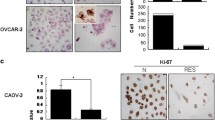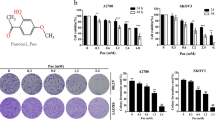Abstract
S1, a novel BH3 mimetic, can induce apoptosis dependent on Bax/Bak through inhibition of Bcl-2 in various tumors. S1 also induces autophagy through interrupting the interaction of Bcl-2 and Beclin1. Our results showed that S1 induces apoptosis in human ovarian cancer SKOV3 cells in a time- and dose-dependent manner. Autophagy precedes apoptosis, in SKOV3 cells treated with S1 (6 μmol/L), autophagy reached the maximum peak at 12 h after treatment and decreased to 24 h. In SKOV3 cells treated with different concentrations of S1 for 24 h, the highest level of autophagy was observed with 5 μmol/L and decreased to 10 μmol/L. Autophagy inhibitors 3-MA and CQ enhanced apoptosis induced by S1 in SKOV3 cells. However, overactivation of caspases in apoptosis induced by S1 may inhibit the autophagy-inducing function of Beclin1. Because the pan-caspase inhibitor Z-VAD recovered the autophagy-inducing function of Beclin1 through reduction of activated caspase-mediated cleavage of Beclin1. Furthermore, the Beclin1 cleavage products could further increase apoptosis induced by S1 in SKOV3 cells. This indicates that apoptosis induced by high doses and long exposure of S1 causes the overactivation of caspases and subsequent cleavage of Beclin1, and inhibits the protection of autophagy. Moreover, the cleaved product of Beclin1 further promotes apoptosis induced by S1 in SKOV3 cells. Our results suggest this may be a molecular mechanism for enhancing the sensitivity of cancer cells to apoptosis induced by small molecular compound targeting Bcl-2.







Similar content being viewed by others
Abbreviations
- Bcl:
-
B cell lymphoma
- BH:
-
Bcl-2 homology
- Mcl-1:
-
Myeloid cell leukaemia-1
- IL-3:
-
Interleukin3
- 3-MA:
-
3-Methyladenine
- CQ:
-
Chloroquine
- Z-VAD:
-
Z-Val-Aal-DL-Asp-FMK
- TRAIL:
-
Tumor necrosis factor related apoptosis-inducing ligand
- RNase L:
-
Ribonuclease L
References
Mukhopadhyay S, Panda PK, Sinha N, Das DN, Bhutia SK (2014) Autophagy and apoptosis: where do they meet? Apoptosis 19:555–566
Zhong JT, Xu Y, Yi HW, Su J, Yu HM, Xiang XY, Li XN, Zhang ZC, Sun LK (2012) The BH3 mimetic S1 induces autophagy through ER stress and disruption of Bcl-2/Beclin 1 interaction in human glioma U251 cells. Cancer Lett 323:180–187
Wirawan E, Vande Walle L, Kersse K, Cornelis S, Claerhout S, Vanoverberghe I, Roelandt R, De Rycke R, Verspurten J, Declercq W, Agostinis P, Vanden Berghe T, Lippens S, Vandenabeele P (2010) Caspase-mediated cleavage of Beclin-1 inactivates Beclin-1-induced autophagy and enhances apoptosis by promoting the release of proapoptotic factors from mitochondria. Cell Death Dis 1:e18
Cho DH, Jo YK, Hwang JJ, Lee YM, Roh SA, Kim JC (2009) Caspase-mediated cleavage of ATG6/Beclin-1 links apoptosis to autophagy in HeLa cells. Cancer Lett 274:95–100
Luo S, Rubinsztein DC (2010) Apoptosis blocks Beclin 1-dependent autophagosome synthesis: an effect rescued by Bcl-xL. Cell Death Differ 17:268–277
Li H, Wang P, Sun Q, Ding WX, Yin XM, Sobol RW, Stolz DB, Yu J, Zhang L (2011) Following cytochrome c release, autophagy is inhibited during chemotherapy-induced apoptosis by caspase 8-mediated cleavage of Beclin 1. Cancer Res 71:3625–3634
Siddiqui MA, Mukherjee S, Manivannan P, Malathi K (2015) RNase L cleavage products promote switch from autophagy to apoptosis by caspase-mediated cleavage of Beclin-1. Int J Mol Sci 16:17611–17636
Cheng EH, Wei MC, Weiler S, Flavell RA, Mak TW, Lindsten T, Korsmeyer SJ (2001) BCL-2, BCL-X(L) sequester BH3 domain-only molecules preventing BAX- and BAK-mediated mitochondrial apoptosis. Mol Cell 8:705–711
Chittenden T, Flemington C, Houghton AB, Ebb RG, Gallo GJ, Elangovan B, Chinnadurai G, Lutz RJ (1995) A conserved domain in Bak, distinct from BH1 and BH2, mediates cell death and protein binding functions. EMBO J 14:5589–5596
Lindsten T, Ross AJ, King A, Zong WX, Rathmell JC, Shiels HA, Ulrich E, Waymire KG, Mahar P, Frauwirth K, Chen Y, Wei M, Eng VM, Adelman DM, Simon MC, Ma A, Golden JA, Evan G, Korsmeyer SJ, MacGregor GR, Thompson CB (2000) The combined functions of proapoptotic Bcl-2 family members bak and bax are essential for normal development of multiple tissues. Mol Cell 6:1389–1399
Puthalakath H, Strasser A (2002) Keeping killers on a tight leash: transcriptional and post-translational control of the pro-apoptotic activity of BH3-only proteins. Cell Death Differ 9:505–512
Rathmell JC, Lindsten T, Zong WX, Cinalli RM, Thompson CB (2002) Deficiency in Bak and Bax perturbs thymic selection and lymphoid homeostasis. Nat Immunol 3:932–939
Yin XM, Oltvai ZN, Korsmeyer SJ (1994) BH1 and BH2 domains of Bcl-2 are required for inhibition of apoptosis and heterodimerization with Bax. Nature 369:321–323
Zong WX, Lindsten T, Ross AJ, MacGregor GR, Thompson CB (2001) BH3-only proteins that bind pro-survival Bcl-2 family members fail to induce apoptosis in the absence of Bax and Bak. Genes Dev 15:1481–1486
Perego P, Cossa G, Zuco V, Zunino F (2010) Modulation of cell sensitivity to antitumor agents by targeting survival pathways. Biochem Pharmacol 80:1459–1465
Coultas L, Strasser A (2003) The role of the Bcl-2 protein family in cancer. Semin Cancer Biol 13:115–123
Yu L, Liu S (2013) Autophagy contributes to modulating the cytotoxicities of Bcl-2 homology domain-3 mimetics. Semin Cancer Biol 23:553–560
Kang R, Zeh HJ, Lotze MT, Tang D (2011) The Beclin 1 network regulates autophagy and apoptosis. Cell Death Differ 18:571–580
Maiuri MC, Le Toumelin G, Criollo A, Rain JC, Gautier F, Juin P, Tasdemir E, Pierron G, Troulinaki K, Tavernarakis N, Hickman JA, Geneste O, Kroemer G (2007) Functional and physical interaction between Bcl-X(L) and a BH3-like domain in Beclin-1. EMBO J 26:2527–2539
Kang MH, Reynolds CP (2009) Bcl-2 inhibitors: targeting mitochondrial apoptotic pathways in cancer therapy. Clin Cancer Res 15:1126–1132
Gao P, Bauvy C, Souquere S, Tonelli G, Liu L, Zhu Y, Qiao Z, Bakula D, Proikas-Cezanne T, Pierron G, Codogno P, Chen Q, Mehrpour M (2010) The Bcl-2 homology domain 3 mimetic gossypol induces both Beclin 1-dependent and Beclin 1-independent cytoprotective autophagy in cancer cells. J Biol Chem 285:25570–25581
Schwartz-Roberts JL, Shajahan AN, Cook KL, Warri A, Abu-Asab M, Clarke R (2013) GX15-070 (obatoclax) induces apoptosis and inhibits cathepsin d- and l-mediated autophagosomal lysis in antiestrogen-resistant breast cancer cells. Mol Cancer Ther 12:448–459
Liu N, Xu Y, Sun JT, Su J, Xiang XY, Yi HW, Zhang ZC, Sun LK (2013) The BH3 mimetic S1 induces endoplasmic reticulum stress-associated apoptosis in cisplatin-resistant human ovarian cancer cells although it activates autophagy. Oncol Rep 30:2677–2684
Hou W, Han J, Lu C, Goldstein LA, Rabinowich H (2008) Enhancement of tumor-TRAIL susceptibility by modulation of autophagy. Autophagy 4:940–943
Han J, Hou W, Goldstein LA, Lu C, Stolz DB, Yin XM, Rabinowich H (2008) Involvement of protective autophagy in TRAIL resistance of apoptosis-defective tumor cells. J Biol Chem 283:19665–19677
Zhang Z, Jin L, Qian X, Wei M, Wang Y, Wang J, Yang Y, Xu Q, Xu Y, Liu F (2007) Novel Bcl-2 inhibitors: discovery and mechanism study of small organic apoptosis-inducing agents. ChemBioChem 8:113–121
Zhang Z, Song T, Zhang T, Gao J, Wu G, An L, Du G (2010) A novel BH3 mimetic S1 potently induces Bax/Bak-dependent apoptosis by targeting both Bcl-2 and Mcl-1. Int J Cancer 128:1724–1735
Rubinsztein DC, Gestwicki JE, Murphy LO, Klionsky DJ (2007) Potential therapeutic applications of autophagy. Nat Rev Drug Discov 6:304–312
Luo S, Rubinsztein DC (2009) Apoptosis blocks Beclin 1-dependent autophagosome synthesis: an effect rescued by Bcl-xL. Cell Death Differ 17:268–277
Buggins AG, Pepper CJ (2010) The role of Bcl-2 family proteins in chronic lymphocytic leukaemia. Leuk Res 34:837–842
Yang E, Korsmeyer SJ (1996) Molecular thanatopsis: a discourse on the BCL2 family and cell death. Blood 88:386–401
Youle RJ, Strasser A (2008) The BCL-2 protein family: opposing activities that mediate cell death. Nat Rev Mol Cell Biol 9:47–59
Pan J, Cheng C, Verstovsek S, Chen Q, Jin Y, Cao Q (2010) The BH3-mimetic GX15-070 induces autophagy, potentiates the cytotoxicity of carboplatin and 5-fluorouracil in esophageal carcinoma cells. Cancer Lett 293:167–174
Booth LA, Tavallai S, Hamed HA, Cruickshanks N, Dent P (2014) The role of cell signalling in the crosstalk between autophagy and apoptosis. Cell Signal 26:549–555
Djavaheri-Mergny M, Maiuri MC, Kroemer G (2010) Cross talk between apoptosis and autophagy by caspase-mediated cleavage of Beclin 1. Oncogene 29:1717–1719
Acknowledgments
The research was supported by the National Natural Science Foundation of China (Grant numbers: 81372793, 81272876 and 81202552).
Author information
Authors and Affiliations
Corresponding author
Ethics declarations
Conflict of interest
The authors declare that they have no conflict of interest.
Additional information
Xiaoning Li and Jing Su contributed equally to this study.
Rights and permissions
About this article
Cite this article
Li, X., Su, J., Xia, M. et al. Caspase-mediated cleavage of Beclin1 inhibits autophagy and promotes apoptosis induced by S1 in human ovarian cancer SKOV3 cells. Apoptosis 21, 225–238 (2016). https://doi.org/10.1007/s10495-015-1197-y
Published:
Issue Date:
DOI: https://doi.org/10.1007/s10495-015-1197-y




